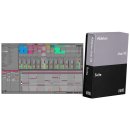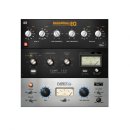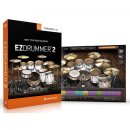What is a DAW and how does it enhance music production?
A Digital Audio Workstation (DAW) is the backbone of modern music production, serving as the primary platform for recording, editing, mixing, and mastering audio. Whether you're working in a professional studio or a home setup, understanding what a DAW is and how it enhances music production is crucial for any music producer. DAWs have revolutionized the music industry by providing a versatile and powerful environment where musicians can compose, arrange, and produce their work with unprecedented precision and flexibility. The best music software for beginners often includes a DAW with a user-friendly interface, allowing new producers to dive into music production without being overwhelmed by complex features. DAWs vary widely in terms of functionality, from basic versions with limited tracks and plugins to advanced setups that support unlimited tracks, automation, and integration with external hardware. Choosing the right DAW for your music style and production needs is essential for maximizing your creative potential. DAWs like these are also known for their ability to integrate seamlessly with other music software, such as virtual instruments and effect plugins, enabling a complete music production workflow within a single application. One of the primary benefits of using a DAW is the ability to manipulate audio with precision. This includes cutting, trimming, and rearranging audio clips, as well as applying effects and processing in real-time. DAWs also support MIDI sequencing, allowing producers to compose and edit music using virtual instruments. These capabilities make DAWs indispensable for both electronic music production and traditional recording techniques. For those working in a home studio, selecting a DAW that suits your workflow can be a game-changer, turning a simple setup into a powerful music production hub. Moreover, DAWs are integral to live performance setups, where they are used to trigger samples, sequence MIDI, and apply live effects. Music software for live performance setups often includes specialized DAWs or DAW modes designed to enhance stability and real-time control. This flexibility allows musicians to use their DAW not only as a production tool but also as an instrument in its own right, providing endless possibilities for creativity during live shows. In summary, a DAW is much more than just a piece of music software; it is the heart of the music production process. By offering a wide range of tools for recording, editing, and mixing, a DAW enables producers to create high-quality music efficiently and effectively. Whether you're just starting or are an advanced user, the right DAW can significantly enhance your music production capabilities, making it an essential investment for anyone serious about creating music.
Choosing the right DAW for your music style
Selecting the right DAW (Digital Audio Workstation) is a critical decision for any music producer, as it can greatly influence your workflow, creativity, and the quality of your final product. With a plethora of options available, each catering to different music styles and production needs, it's important to understand how to choose the right music software for your specific genre and workflow. When choosing a DAW, consider your primary music style. For instance, electronic music producers might prefer a DAW with strong MIDI capabilities, advanced automation, and a wide range of built-in virtual instruments. On the other hand, those focusing on recording live bands or acoustic music might prioritize DAWs that offer superior audio recording and editing tools. The best music software for beginners often includes features that are easy to navigate yet powerful enough to grow with the user as their skills develop. Another important factor is the DAW's integration with other music software and hardware. If you rely heavily on virtual instruments or external synthesizers, you'll want a DAW that offers seamless MIDI integration and low-latency performance. DAWs that support VST, AU, or AAX plugins are highly versatile, allowing you to expand your sound palette with third-party audio plugins. These plugins can range from simple effect units to complex virtual instruments, each offering unique sounds and capabilities that can greatly enhance your productions. For those working in a home studio, it's also essential to consider the DAW's compatibility with your existing equipment. Music software for home studio recording should be able to interface smoothly with your audio interface, MIDI controllers, and other hardware. Some DAWs offer customizable templates and workflows tailored to specific genres, making it easier to get started on new projects without having to set up everything from scratch each time. Budget is another crucial consideration. While professional DAWs can be quite expensive, there are also many affordable music software options that offer excellent value for money. These budget-friendly DAWs often include essential features like multi-track recording, basic effects, and virtual instruments, making them ideal for beginners or those working with limited resources. However, as you progress in your music production journey, you may find it beneficial to invest in a more advanced DAW that offers a broader range of features and higher-quality processing. Finally, it's important to think about future upgrades. As your production skills improve, you may want to expand your setup with additional plugins, virtual instruments, or even upgrade your DAW to a more advanced version. Choosing a DAW that offers a clear upgrade path can save you time and money in the long run, ensuring that your music software continues to meet your needs as you evolve as a producer. In conclusion, selecting the right DAW is a deeply personal decision that depends on your music style, workflow, and long-term goals. By considering these factors carefully, you can choose music software that enhances your creativity and helps you achieve professional-quality results.
The importance of audio plugins in modern music production
Audio plugins have become indispensable tools in modern music production, offering producers a vast array of options for shaping and enhancing their sound. These software-based tools, which can be added to a DAW, are essential for creating professional-quality music, regardless of the genre. Understanding the importance of audio plugins in modern music production can help you make informed decisions when building your plugin library and integrating them into your workflow. At the core of many music production setups are effect plugins, which include tools like reverb, delay, compression, and equalization. These plugins allow producers to manipulate the tonal balance, dynamic range, and spatial characteristics of their tracks, adding depth and polish to the final mix. For example, using reverb and delay plugins can create a sense of space and dimension in your recordings, making them sound more natural and immersive. On the other hand, compression and EQ plugins are essential for controlling dynamics and frequency balance, ensuring that each element of the mix fits together cohesively. Another critical category is virtual instruments, which are software-based emulations of traditional instruments like pianos, drums, and synthesizers. These instruments can be played and recorded directly within your DAW, offering a level of convenience and flexibility that is unmatched by physical instruments. Virtual instruments can transform your compositions by providing access to a wide range of sounds and textures, from realistic orchestral libraries to cutting-edge synth patches. Music software with built-in virtual instruments is particularly valuable for producers who want to expand their sonic palette without investing in expensive hardware. For those focused on electronic music production, the importance of audio plugins cannot be overstated. Synthesizer plugins, drum machines, and sequencers are fundamental tools for creating the unique sounds and rhythms that define this genre. By integrating these plugins into your DAW, you can explore new creative possibilities and push the boundaries of your music. Advanced effect plugins for music software also play a crucial role in electronic music, allowing producers to design complex soundscapes and intricate rhythmic patterns. Organizing your plugin library is another important aspect of working with audio plugins. As your collection grows, it can become challenging to find the right tool for the job. Best practices for organizing your audio plugin library include categorizing plugins by type (e.g., effects, instruments), manufacturer, or specific use case. This organization not only streamlines your workflow but also ensures that you can quickly access the tools you need during a session, keeping your creative momentum going. In conclusion, audio plugins are vital components of modern music production, providing the tools needed to shape, enhance, and transform your sound. Whether you're using basic effect plugins or complex virtual instruments, integrating these tools into your DAW can significantly improve the quality and creativity of your music. By carefully selecting and organizing your plugins, you can build a powerful music production setup that supports your artistic vision and helps you achieve professional results.
How virtual instruments can transform your compositions
Virtual instruments have revolutionized the way music is composed and produced, offering musicians and producers an unparalleled range of sounds and creative possibilities. These software-based instruments emulate the sounds of traditional instruments, as well as provide entirely new sonic textures that are not possible with physical instruments. Understanding how virtual instruments can transform your compositions is essential for modern music production, whether you’re working in a home studio or a professional environment. One of the most significant advantages of virtual instruments is their versatility. Unlike physical instruments, which are often limited by their construction and physical properties, virtual instruments can produce an almost infinite variety of sounds. From realistic orchestral strings and pianos to futuristic synthesizers and drum machines, virtual instruments cover every conceivable genre and style. This versatility allows you to experiment with different sounds and textures, opening up new creative avenues for your compositions. Moreover, virtual instruments are incredibly convenient. Instead of needing to record a live musician every time you want to add an instrument to a track, you can simply load a virtual instrument in your DAW and start playing. This convenience is particularly valuable in a home studio setting, where space and resources might be limited. Music software for home studio recording often includes a selection of built-in virtual instruments, providing everything you need to start creating music right out of the box. Another key benefit of virtual instruments is their ability to integrate seamlessly with your existing music software. By loading virtual instruments into your DAW, you can easily incorporate them into your compositions, using MIDI to control every aspect of the performance. This integration allows for precise editing and automation, enabling you to fine-tune your compositions in ways that would be difficult or impossible with physical instruments. For example, you can automate volume changes, pitch bends, and other parameters to create dynamic, expressive performances. In addition to traditional instruments, virtual instruments also include innovative tools that can transform your compositions in unique ways. These might include granular synthesizers, spectral processors, and other cutting-edge technologies that allow you to manipulate sound at a fundamental level. By experimenting with these tools, you can create entirely new sounds and textures, pushing the boundaries of your music and exploring new creative directions. Finally, virtual instruments are often more affordable than their physical counterparts. While high-quality acoustic instruments can be prohibitively expensive, virtual instruments offer a cost-effective alternative that delivers professional-quality sound. Affordable music software packages often include a range of virtual instruments, making it easier for producers on a budget to access high-quality sounds without breaking the bank. In conclusion, virtual instruments are powerful tools that can transform your compositions by offering versatility, convenience, and innovation. Whether you're composing orchestral music, electronic beats, or anything in between, virtual instruments provide the sounds and flexibility needed to bring your creative vision to life.
Understanding the different types of effect plugins
Effect plugins are essential tools in music production, allowing producers to shape and enhance their tracks in various ways. These plugins can be used to add reverb, delay, compression, and other effects to your recordings, helping you achieve a polished, professional sound. Understanding the different types of effect plugins is crucial for any producer looking to expand their sonic toolkit and create high-quality music. One of the most commonly used types of effect plugins is reverb. Reverb plugins simulate the natural reflections of sound in a physical space, adding depth and ambience to your recordings. By adjusting the parameters of a reverb plugin, such as decay time and room size, you can create anything from a subtle sense of space to a vast, cavernous echo. Reverb is particularly useful for adding a sense of realism to virtual instruments, making them sound as if they were recorded in a physical room rather than a computer. Delay is another essential effect plugin, often used to create echoes and rhythmic patterns. Delay plugins repeat the input signal at set intervals, which can be synchronized to the tempo of your track. By adjusting the feedback and mix levels, you can create everything from a short slapback echo to a complex, cascading delay effect. Delay is commonly used in electronic music to add movement and complexity to synth lines, but it can be equally effective in other genres, such as rock and pop. Compression plugins are vital for controlling the dynamic range of your recordings. By reducing the difference between the loudest and quietest parts of a track, compression helps to create a more balanced and consistent sound. Compression is particularly important in modern music production, where maintaining a competitive loudness level is crucial. However, it's important to use compression carefully, as over-compression can lead to a lifeless, flattened sound. Understanding how to use compression plugins effectively is key to achieving a professional-quality mix. Equalization (EQ) plugins are another fundamental tool in music production. EQ plugins allow you to adjust the frequency balance of your tracks, either by boosting or cutting specific frequencies. This can be useful for removing unwanted resonances, enhancing the clarity of vocals, or shaping the overall tonal balance of a mix. Advanced EQ plugins often include features such as dynamic EQ, which allows you to apply different EQ settings depending on the volume of the signal, providing even greater control over your sound. Finally, there are more specialized effect plugins, such as distortion, chorus, and modulation effects, each offering unique ways to shape and color your sound. Distortion plugins can add grit and saturation to your tracks, making them sound more aggressive and powerful. Chorus and modulation effects, on the other hand, can add movement and depth to your recordings, creating lush, swirling textures that can enhance everything from vocals to synth pads. In conclusion, understanding the different types of effect plugins is essential for any producer looking to create high-quality music. Whether you're using reverb to add space, delay to create rhythmic patterns, or EQ to shape the tonal balance, these plugins are indispensable tools in the music production process. By mastering these effects, you can unlock new creative possibilities and take your productions to the next level.
The benefits of upgrading your music software
Upgrading your music software can have a profound impact on your music production capabilities, providing you with access to new features, improved performance, and the latest technology. While it may be tempting to stick with the software you know, the benefits of upgrading your music software are often well worth the investment, particularly for those serious about achieving professional-quality results. One of the primary benefits of upgrading is access to new features and tools. Music software developers are constantly innovating, adding new functionality that can enhance your workflow and expand your creative options. This might include new virtual instruments, advanced effect plugins, or enhanced MIDI capabilities. By upgrading, you can stay on the cutting edge of music production, ensuring that you have the tools you need to create the best possible music. Improved performance is another significant benefit of upgrading your music software. Newer versions of software are often optimized for the latest operating systems and hardware, resulting in faster load times, smoother operation, and reduced latency. This is particularly important for those working in a home studio, where every second counts. Music software for home studio recording often includes performance improvements that make it easier to handle complex projects without running into technical issues. Upgrading your music software can also provide better support for new technologies. As the music production landscape evolves, new formats, protocols, and hardware are constantly being introduced. By keeping your software up to date, you ensure that you can take advantage of these advancements, whether it's integrating new audio interfaces, using the latest virtual instruments, or working with cutting-edge audio formats. Another advantage of upgrading is the increased stability and security that comes with newer software versions. Developers regularly release updates that fix bugs, patch security vulnerabilities, and improve overall stability. By upgrading, you can avoid potential issues that could disrupt your workflow or compromise the security of your projects. This is particularly important in a professional studio setting, where downtime can be costly and deadlines are tight. Finally, upgrading your music software can lead to better support and community engagement. Newer versions of software often come with updated documentation, tutorials, and access to online communities where you can share tips, ask questions, and learn from other users. This can be invaluable for both beginners and advanced users, providing a wealth of resources to help you get the most out of your software. In conclusion, the benefits of upgrading your music software are numerous, from accessing new features and improved performance to staying compatible with the latest technology. Whether you're working in a home studio or a professional environment, keeping your software up to date is essential for maintaining a smooth, efficient workflow and achieving the best possible results in your music production.







